NYC’s Forgotten ‘War on Christmas Trees’
Discover how an obscure holiday crackdown affects festive street vendors today!


Continuing our architectural journey in Israel, we turn now to its principal city; the beating economic heart of the country, Tel Aviv. Its very name bespeaks the juxtapositions that lie at the core of this Mediterranean metropolis: Tel is an ancient Hebrew word denoting a mound or hill created by layer upon layer of human civilisation and Aviv is the Hebrew word for spring. Quite an ironic, or at least hopeful name for a city built ex-nihilo on sand dunes by the sea. But the layers of civilisation were not absent at its birth, rather they came from elsewhere. Tel Aviv, though young and fresh, was a culmination, of sorts, of a historical process of urban development in the European city. The dreams of European architects and urban designers cast in concrete on the shores of the Mediterranean; the apogee of High Modernist austerity for a nation of pioneers.
Still the city’s name has more secrets to reveal. Speaking to rebirth and renewal, Aviv (spring), is testament to the flourishing community those pioneers intended to build. Yet, more literally, it suggests man in harmony with his environment, a city built within nature, not without it. Unlike its planned, modernist counterparts in other young nations, Chandigarh, say, or Brasilia, Tel Aviv was never intended to be large, nor important. In fact, it was conceived as a garden suburb, another idea then gestating in Europe, in the country towns and villages around London. Sir Patrick Geddes, the Scottish biologist and town planner devised a street plan based on Ebenezer Howard’s garden city movement: a limited population, human scale and abundant greenery.
Today, Tel Aviv has matured into a metropolis, yet it continues to inhabit the body of its earlier incarnation. This contradiction gives Tel Aviv its unique feel, as the sheer dynamism of its street life overwhelms the austerity and conformity that often blight modernist place-making. Shops, cafés, bakeries, bars spill out onto the city’s bustling boulevards, yet round the block, residential side streets greet you with lush foliage, dignified and reassuringly repetitive apartment blocks that keep any metropolitan hubris in check.

In the 1920s and 30s, exiled Jewish-German architects of the Bauhaus School set to work filling the empty lots of new Tel Aviv with striking buildings of brilliant white, eschewing frills for decorative purity and geometric form. They conjured a Weissenhofsiedlung sur mer, with a generosity of space and lightness of spirit that was inspired, perhaps, by the gentle climate and luminosity of the Mediterranean basin.
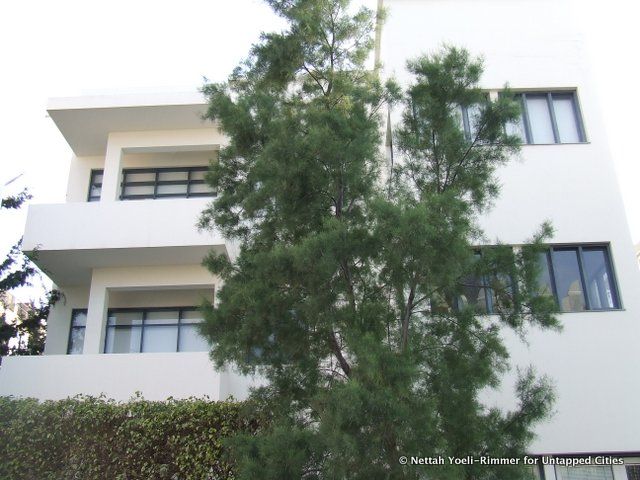
The imposing and elegant Bauhaus style is the fundamental building block of Tel Aviv. Their clean lines and dazzling whiteness create a beautiful blank canvas, on which the sun and shadow engage in dance, framed by the bucolic greenery of the city’s streets. Pioneering standardised construction techniques and championing the use of cheap materials, the Bauhaus, or International Style, saw itself as an architectural panacea; the universal future of cities. The utopian vision often fell short of expectations, creating a host of eerily familiar and sterile non-places (see Augé). In this youthful and dynamic Mediterranean city, however, the rootlessness of the International Style seems very appropriate; its cosmopolitanism feels right at home in this city of immigrants.

Though Tel Aviv can boast a higher concentration of Bauhaus buildings than any other city on earth, it is by no means a harmonious bastion of glittering white. Wonderful as this would no doubt be, the city sadly contains many examples of cheaper infill, mostly in the form of monolithic residential blocks. In many cases, the only visible legacy of the Bauhaus School is in the form of standardised boxes of dubious quality, making use, like the master architects, of cheap materials, but shorn of the aesthetic nuance and technical competence of the original movement.

Before the Geddes Plan and the arrival of the Bauhaus architects, the fledgling city, then under Ottoman rule, was largely built in the Eclectic Style, a flamboyant and freewheeling architecture. The style was largely based on classical building types with the addition of Orientalist motifs, Jewish themes, or Romantic features.
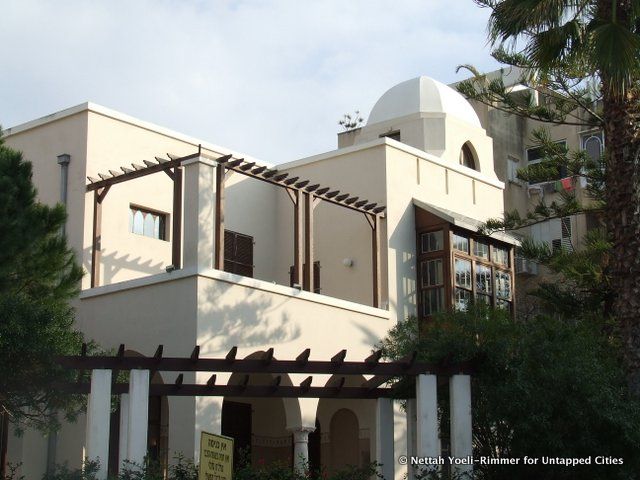
Since most new buildings at that time were private family homes, individually designed and commissioned, there is a great degree of variety.
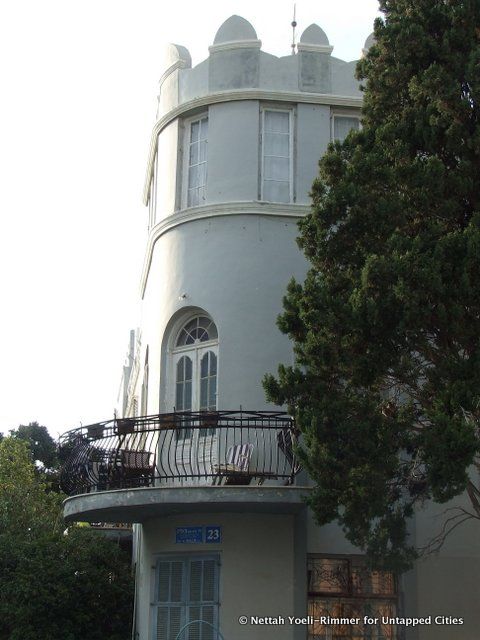
Many such buildings are to be found in the gentrifying Neve Tsedek neighbourhood, where the crumbling Eden Cinema is to be found; the city’s first, opened in 1914.
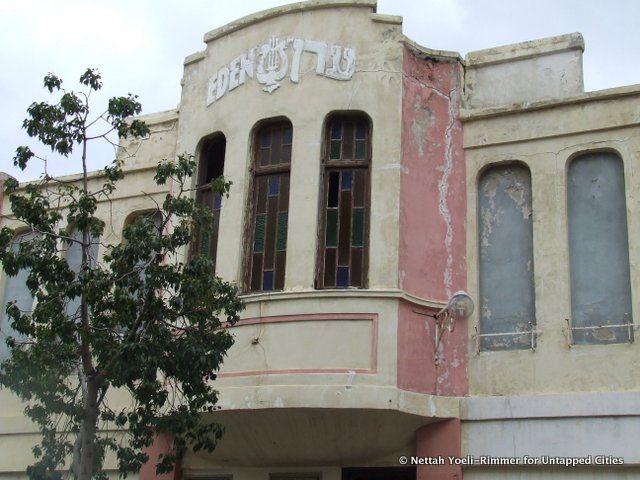
The future of Tel Aviv
The Eden Cinema closed its doors in 1974, during a decade that witnessed a low point in the city’s architecture. The period saw the ham-fisted work of Brutalist architects and aggressive urban planners, who set about transforming the city’s face, with scant understanding for the integrity of the Geddes plan and the modest craftsmanship of the Bauhaus architecture. Their addition to the city’s heritage came in the form of concrete banalities and nondescript hotel towers. These were particularly built along the seafront, thereby cutting the city off visually from its shoreline, with a wall of architecturally inept towers.
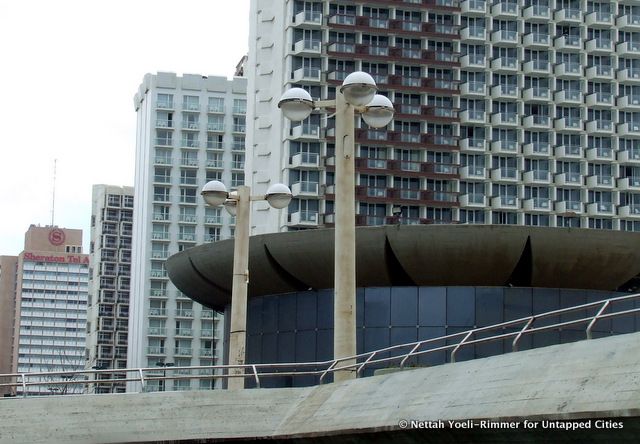
This disregard for the city’s heritage saw scores of Bauhaus buildings demolished or left to rot, while 1972 was marked with the construction of the Dizengoff Centre by architects Yitshak Yashar. This boxy shopping centre spills over both sides of Tel Aviv’s principal artery; a piece of suburbia catapulted into the city by the gods of consumerism. Worse was to come in 1978, with the remodelling of Dizengoff Square to accommodate traffic flows. A key part of Geddes’ plan, the square was built in 1934 as an elegant plaza. Mayor Shlomo Lahat’s widening of the roads and construction of an elevated pedestrian walkway spectacularly destroyed the square’s proportions and visual coherence, leading to its degradation along with its surrounding buildings.
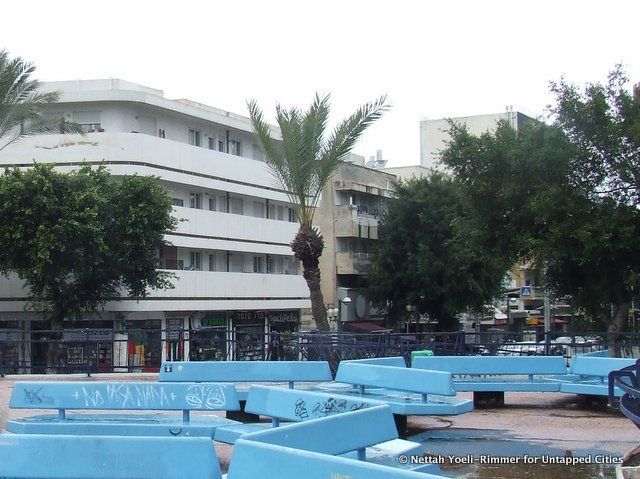 A desolate square in the sky, cut off from the street and surrounded by decaying Bauhaus buildings
A desolate square in the sky, cut off from the street and surrounded by decaying Bauhaus buildings
The latest phase in the city’s development is increasingly market-led, with a strong push for new and haphazard construction. With the Israeli economy now firmly operating in the neo-Liberal mode of production, Tel Aviv, as its major city, competes with other global cities in the pursuit of iconic landmarks and buildings that soar, Babel-like, to the heavens. The Opera Tower, built on the site of the former municipal opera house, and finished in 1993, is typical of the Postmodernist turn in Israeli corporate architecture. Its pink arched balconies perform a representation of the authentic arched windows of the opera house that it replaced.

The nod to heritage within the Postmodernist tradition, however glib and ultimately futile, does seem to have fomented a reappraisal of the role of heritage in the built environment. Indeed, some recent architecture in the city self-consciously imitates the angularity of the Bauhaus style, mixing it with contemporary techniques to create a sort of Bauhaus Revival, without fully returning to the craftsmanship of the original school.
 Modern versions of the Bauhaus, centre and right. Left, an ‘iconic’ hotel tower reaches for the sky
Modern versions of the Bauhaus, centre and right. Left, an ‘iconic’ hotel tower reaches for the sky
Nevertheless, despite its UNESCO World Heritage status, which guarantees the partial preservation of over 1000 Modernist buildings, clumsy development continues to denature the city’s human scale and the sprouting of faceless corporate towers and luxury condos throughout the city threatens to rupture the continuity of the street plan, destabilise the socioeconomic mix and undermine the Mediterranean street life that is so characteristic of Tel Aviv.
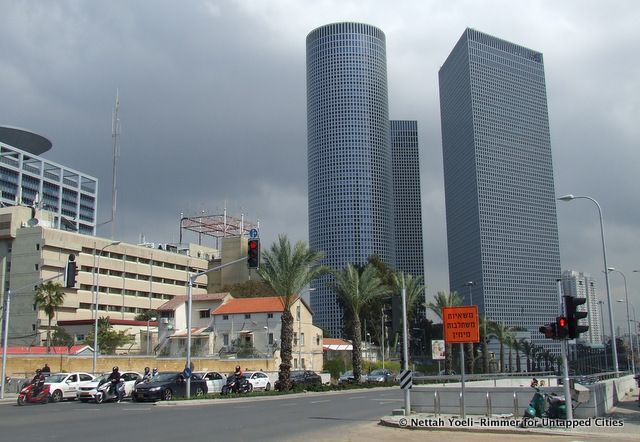 Azrieli towers against a tangle of roadways. A sign of things to come?
Azrieli towers against a tangle of roadways. A sign of things to come?
As seen below, unusual juxtapositions of old and new, crafted and industrial, can be thrilling on a serendipitous encounter; energising the city because of their sheer chutzpah.

If the pace of development continues, however, the new threatens to overwhelm the old, crushing it under the steamroller of progress. Unlike its more demure sister Jerusalem, to follow soon, Tel Aviv faces modernity head on, revelling in its dizzying adventure. It must do so, though, on its own terms if it is to preserve what makes it special and unique. If the forces of standardisation and their minion of skyscrapers colonise the white, winding streets of Geddes’ Tel Aviv, then its architectural, and human, charms will be lost forever.
Come back for part 3 of the series, where we turn our attention to Jerusalem, a city of many architectural styles all built in the same stone.
Follow Untapped Cities on Twitter and Facebook! Get in touch with the author @nettahyr
Subscribe to our newsletter